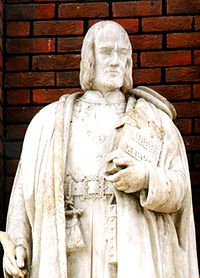John Carpenter, the younger | |
|---|---|
 Statue of John Carpenter by Samuel Nixon, The Great Hall, City of London School | |
| Born | c. 1372; baptised 18 December 1378 Unknown location; baptised Hereford Cathedral |
| Died | Between 8 March 1441 (will) and 12 May 1442 (will proved) – maybe April 1442 Buried in Westminster Abbey |
| Nationality | English |
| Other names | John Carpenter, town clerk of London |
| Occupation(s) | Town Clerk of London, author, founder |
| Known for | Liber Albus, City of London School, Member of Parliament from London |
John Carpenter, the younger (about 1372–1442), was a Town Clerk of London. He was elected as Town Clerk to the City of London during the reigns of Henry V and Henry VI. He was the author of the first book of English common law, called Liber Albus (the White Book). He was a member of the English Parliament from London in 1425. He is also recognized as the founder of the City of London School for boys. He resided in the Parish of St. Peter, Cornhill, London, and was buried in the Abbey of St. Peter, Westminster, where his wife Katherine was later interred.[1]
He is frequently distinguished in historical documents as "John Carpenter, the younger", "John Carpenter, Junior" (incorrectly), and as "John Carpenter, Jenkin". "Jenkin" or "Jenken" is a diminutive of the name John.[2]
John Carpenter was one of three men by that name who were prominent during the 15th century. Both others are mentioned in his will of 1442. One was his brother, John Carpenter the elder, who received much property from his younger brother.[3]
John Carpenter may have been related in some way to the other John Carpenter who was the Warden of St. Anthony's Hospital, Rector of St. Mary Magdalen's, and finally Bishop of Worcester. Bishop John Carpenter was willed, by the subject of this article, "that book on architecture which Master William Cleve gave me". Cleve was King's Chaplain and clerk of the works, and carried out building at the Palace of Westminster and the Tower.
- ^ Carpenter, Amos B. (1898) A Genealogical History of the Rehoboth Branch of the Carpenter Family in America. Also known as the Carpenter Memorial, published 1898 by the Press of Carpenter & Morehouse, Amherst, MA, pp. 3-27. This book contains the will of John Carpenter and his wife Katherine along with sections of Thomas Brewer's 1856 work on John Carpenter.
- ^ This family had French Flemish ancestry in its names. Translations of Jean/Jehan/Jehannes became John in English. Jean or Jehan, the diminutive form, became John the younger, while some Jehans and all Jehannes became John the elder or rarely John the older. For more details see Jenkin.
- ^ Douglas-Smith, A. E. (1965) The City of London School. Oxford, England; 2nd Edition.